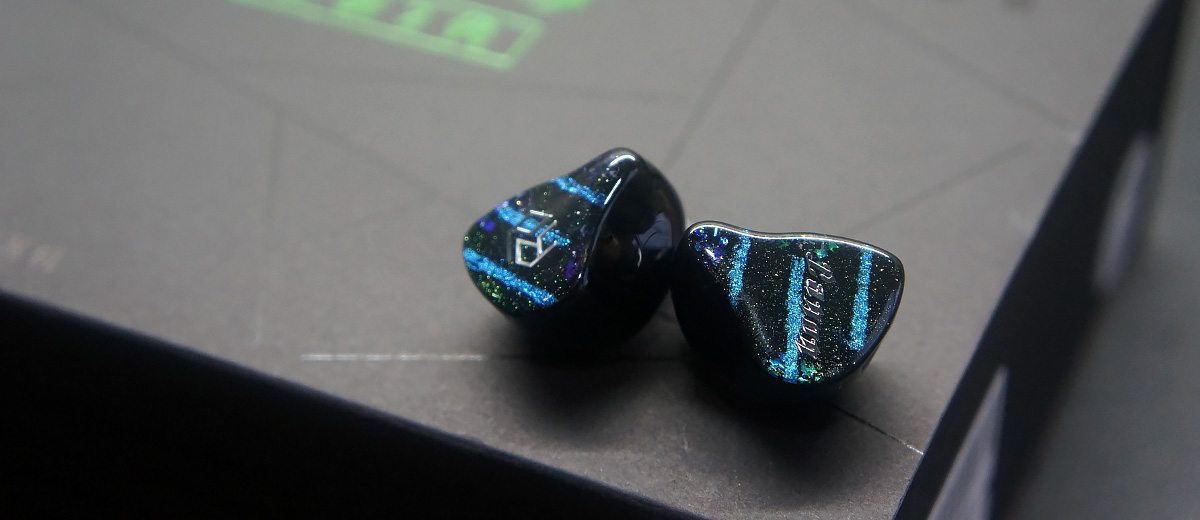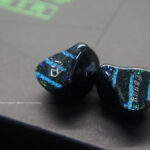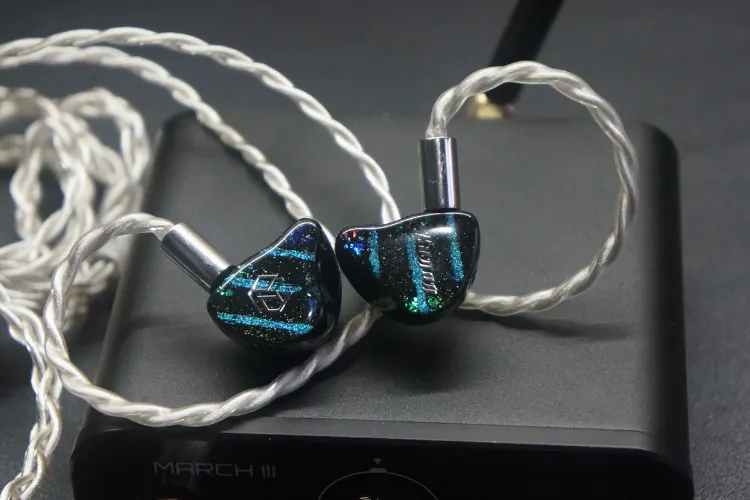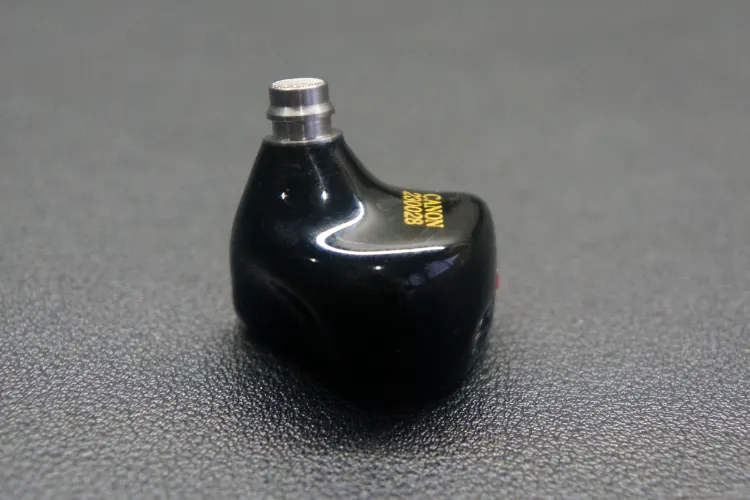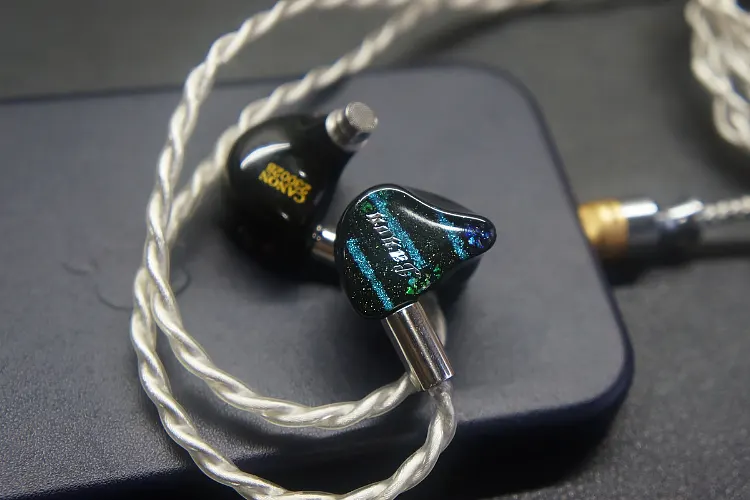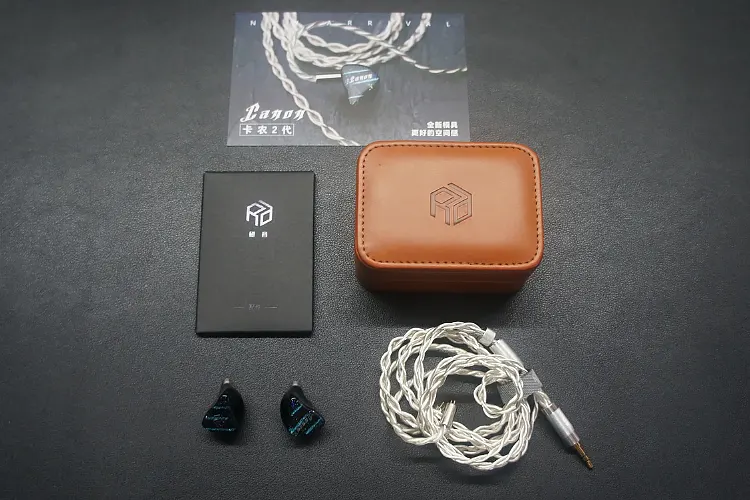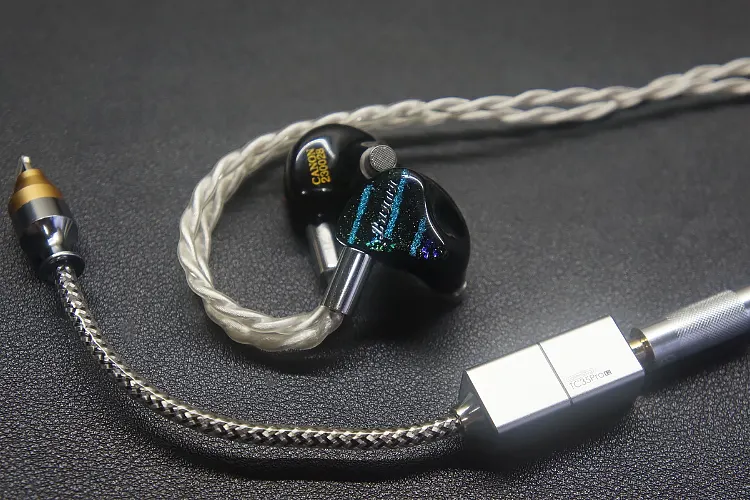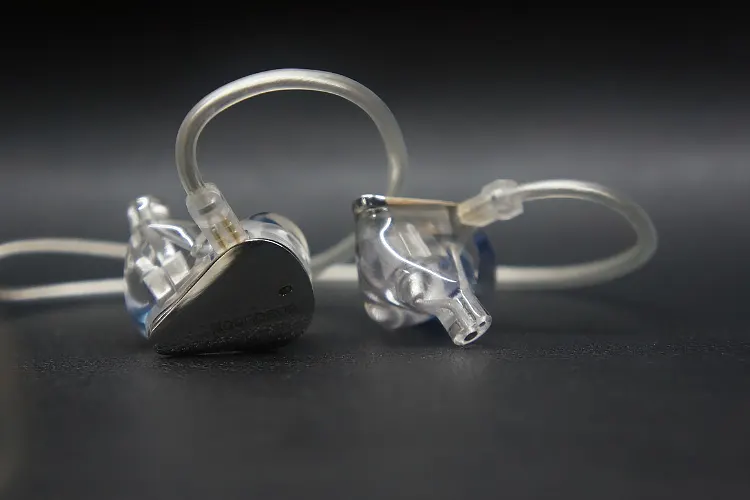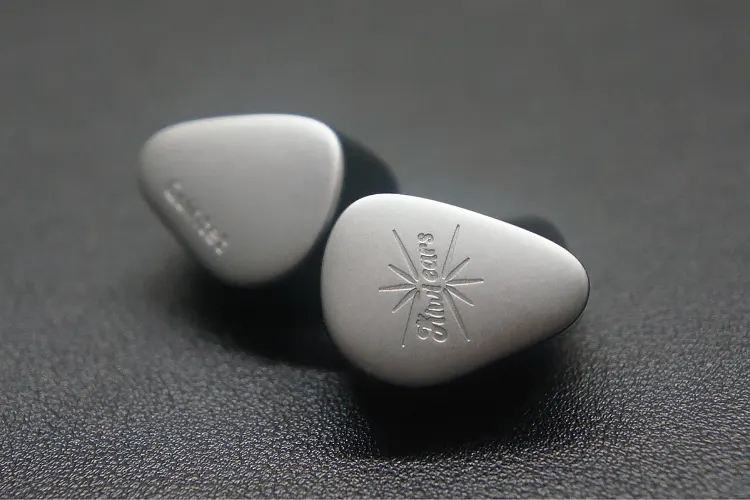We review the Yanyin Canon II, which is a hybrid single biological dynamic and four BA driver universal in-ear monitor with four tuning modes. It is priced at $379.
Disclaimer: This sample was sent to us in exchange for our honest opinion. Headfonics is an independent website with no affiliate links or status. We thank Linsoul Audio for their support.
To read more about Yanyin products we have previously featured on Headfonics, click here.
Note that this article follows our current scoring guidelines which you can read in more detail here.
The Yanyin Canon II is the latest hybrid universal IEM from the Chinese brand Yanyin, a brand we first covered at the end of 2022 with their slightly cheaper Aladdin hybrid model.
The original Canon is the company’s longest-running model and was considered one of the “sleeper hit” IEMs of the past few years.
However, with a refined aesthetic and novel 2-switch tuning system, can the Canon II keep up with its older brother? Let’s find out if its worth slipping into your 11.11 checkout basket!
Tech Highlights
The Canon II is a hybrid 5-driver universal in-ear monitor with a mix of dynamic and balanced armature drivers inside. The precise grouping is a single dynamic driver for the lows combined with four balanced armatures for the mids and the highs.
This is a third-generation bio-diaphragm dynamic driver, which is said to have a faster response, lower distortion, and higher resolution than conventional dynamic drivers.
The driver is also housed in a dual-chamber design, which supposedly optimizes the air pressure balance and enhances the low-frequency dynamics.
The Canon II employs four full-size balanced armature drivers for mid-to-high frequencies. The drivers are arranged in a three-way crossover system.
The Canon II also features two independently controllable low-frequency switches, which offer four tuning modes. The switches are located on the faceplates of the IEMs and can be easily toggled by the user.
These switches allow the user to customize the sound signature according to their preferences and the music genre.
Design
The Canon II has what I would call the classic Chi-Fi shell, a medical-grade resin body with a glossy finish. The shells themselves appear pitch black, unlike other resin IEMs such as the Blessing 3 that like to show off what’s under the hood.
The back side of the shell has yellow text encased within the resin shell. The text is a stylized “Canon” logo, with what appears to be the unit serial number right under it. The finish of the text bears a resemblance to gold leaves with a sparkly finish.
The Canon II does not make use of a separated faceplate and resin body such as the Blessing 3, instead, the whole shell is made out of a singular resin piece.
The faceplates have a galaxy-like pattern, which adds some flair and uniqueness to the IEMs. The faceplates also have the Yanyin logo and the model name engraved on them.
The sides of the shells have small mesh grills that highlight the vented design of the IEMs. The vents are color-coded, with the blue vent signifying the left IEM and the red vent signifying the right IEM. Right under the vent, you’ll see the two tuning switches.
The switches are quite difficult to operate, even with long fingernails. Thankfully, a pin is included to easily flip the two tuning switches
The one-piece resin construction gives it very good build quality, without any visible seams when running my fingernail throughout the IEM shell.
The resin material used holds up well in day-to-day use, doing a good job of not showing fingerprints and micro scratches.
Comfort & Isolation
The Canon II has a smooth and ergonomic shell design that fits comfortably in my ears without any sharp edges or pressure points.
It is around the same size as the Kiwi Ears Quartet, a more budget-oriented IEM that also makes use of a unibody resin design, however, the Canon II’s more tapered shape makes it more comfortable than the Quartet.
The comfort is very good, as I can wear the Canon II for hours without any fatigue or discomfort
For a vented IEM, the isolation performance of the Canon II is quite average, blocking out most of the ambient noise and even medium-volume conversations.
Stock Cable
The Canon II comes with a high-quality cable, which is made of four strands of graphene single-crystal copper plated with silver. The cable has a supple and tangle-free texture.
The detachable cable uses a standard 0.78mm 2-pin connector on one end and a standard 3.5 SE Jack on the other. The cable also has a metal chin slider and a metal Y-splitter with a knurled finish, adding some durability and aesthetics.
Throughout my mixed stationary and on-the-go listening, I observed no microphonics whatsoever. The stock cable does nothing exceptional, but it executes the essentials excellently.
Packaging & Accessories
The Canon II comes in a simple and elegant black box, which has the Yanyin logo and the model name printed on the front. The box has a magnetic flap, which opens to reveal the IEMs and the accessories. The IEMs are placed in a foam cutout, which protects them from damage.
The accessories are stored in a brown leather case, which has the Yanyin logo embossed on it. The case is sturdy and spacious and can fit the IEMs, the included cable, and a dongle DAC with ease. The accessories include four pairs of silicone ear tips a tuning switch tool, and a user manual.
Sound Impressions
Bass
The bass of the Canon II is some of the best I’ve tried thus far. Not only are they dynamic, powerful, and well-extended, but they’re very well-textured as well.
That is a common thread with the Canon II in general; it is a very exciting-sounding IEM, with the detail retrieval one would expect in higher-end neutral IEMS.
I never found the bass quantity lacking. The amount of rumble and impact should be enough for most non-bass heads. Bass hits are textured and well-articulated. Different bass hits do not come off as a bloated mess and are played back with good control.
The bass is well-controlled and textured, without any bleed or bloat. It adds minor warm coloration to the lower mids region, but not as much as other warmer IEMs such as the Tangzu FUDU.
All percussive instruments are a standout with the Canon II, not only because of their fun-sounding tonality but primarily because of the excellent texture level, making different drums easily identifiable from one another.
It is as if the listener is given the ability to break down the individual components of a track while simultaneously enjoying the music.
Mids
The mids of the Canon II are clear and natural, with good detail and articulation. The mids are slightly recessed compared to the bass and treble, but not to the point of being veiled or distant. The mids have good timbre and tonality, which makes the vocals and instruments sound realistic and lifelike.
The slight warmth at the lower midrange gives male vocals a very bodied presentation, playing them back with a palpable sense of authority.
Despite being less forward than the rest of the frequency response range, all aspects of the mid-range have an excellent level of resolution and detail retrieval.
Instruments that sound faint in the background easily catch your attention because of the sheer detail and depth of their playback.
Even compared to other more neutral IEMs, the detail retrieval of the Canon is easily superior. This contributes to the unique combination of implementing a fun-sounding sound signature without sacrificing any detail or resolution whatsoever.
Treble
The treble of the Canon II is crisp and airy, with a good extension and sparkle. The treble is well-articulated and detailed, without any peachiness or fatigue.
It may sound repetitive at this point, but the Canon II’s ability to maintain a pleasing, energetic sound signature without sacrificing detail retrieval is once again a standout.
Treble detail is very good on this set of IEMs, particularly the organic-sounding decay of different cymbals and cymbal strikes. I did not experience any level of sibilance when testing the Canon II, but it still maintained very good detail retrieval.
In my testing, it was usually more sibilant IEMs that had the technical abilities to reach this level of detail retrieval. Thankfully, the Canon II is an exception to this rule.
Imaging
The imaging of the Canon II is precise and coherent, with good separation and layering. The staging performance of the Canon II is quite average, doing so with the width that is expected with a pair of IEMs. However, the Canon II’s imaging performance is quite impressive.
The Canon II can place instruments with pinpoint accuracy, sometimes making certain instruments sound like they’re coming up close behind my ear.
Paired with excellent resolving capabilities across the board, this makes each instrument in the mix easily identifiable.
Synergy
Efficiency
The Canon II is easy enough to drive, thanks to its average 27Ω impedance and a sensitivity rating of 112 dB @1kHz. The earphone can be powered by most devices without the need for an external amplifier.
However, the earphones can benefit from a good source that can provide a clean and powerful sound signal.
In my experience, dongles such as the 7hz SEVENHERTZ 71 or the ddHiFi TC35Pro were able to maximize the paired sound quality.
However, I did notice a slight improvement in imaging capabilities when I powered it with my Topping L30 II desktop amplifier.
Pairings
In my testing, I found that the Canon II paired best with the ddHiFi TC35 in terms of musicality and day-to-day usability. The TC35 did not add any coloration to the sound, maintaining the tonality that I already found quite pleasing.
Additionally, the increased imaging performance that comes with using the IEMs with the Topping L30 II was not significant enough to call TC35 a measurably worse listening experience.
Select Comparisons
Moondrop Blessing 3
Technical
The Moondrop Blessing 3 makes use of a dual dynamic driver and 4 BA drivers as well; however, it has a lower impedance of 14.8Ω and a sensitivity of 100 dB/mW. In practice, I found that the Blessing 3 was harder to drive than the Canon II.
Design
Both IEMs make use of a resin shell, with the main design difference being their faceplates and finishing.
The Yanyin Canon II has a black resin shell with a unibody design, meaning that the faceplate and the shell are all one piece. The faceplate is made of resin as well and shows off a galaxy pattern.
The Blessing 3 is designed with a transparent resin shell, showing off the driver’s inside, while also using a polished steel faceplate with a mirror-like finish.
Performance
The Blessing 3 has a neutral sound signature, while the Canon II has a more exciting, somewhat V-shaped sound signature. The Canon II has a stronger and deeper bass performance and a slightly higher level of bass articulation and texture playback.
Male vocals have more body on the Canon II; however, all other instruments and sounds within the mid-range are presented in a more forward manner on the Blessing 3.
With both IEMs coming in close to one another when it comes to detail retrieval, The Blessing 3’s more neutral signature makes the mid-range sound more evident.
Both IEMS are quite similar in resolving in the treble region, but the Quintet is still more sibilant. This is quite surprising since, in my experience, better-resolving IEMs usually have a more sibilant presentation.
Kiwi Ears Quintet
Technical
The Quintet makes use of a 5-driver configuration with 1 dynamic driver for the lows, 2 balanced armature, and a micro-planar driver for the mids, topped off with a piezoelectric driver for the highs.
It has an impedance of 32Ω and a sensitivity of 108dB @1kHz and is just slightly less sensitive than the Yanyin Canon II, which has an impedance of 27Ω and a sensitivity rating of 112dB @1kHz.
Design
The Yanyin Canon II makes use of a smooth black resin shell with a unibody design, meaning that the faceplate and the shell are all one piece.
The faceplate is made of resin as well and shows off a galaxy pattern, while the Quintet makes use of a 3D-printed resin shell with a separate anodized metal faceplate. I found that the Canon II has a slightly smaller shell and fits slightly better than the Quintet.
Performance
The Canon II has the stronger and deeper bass performance while also having a higher level of bass articulation and texture playback.
Bass hits are not only more satisfying on the Canon II but they are presented with better texture and articulation as well. Bass guitar strums and bass drum hits are richer on the Canon II, and this feeling of warmth extends into the mid-range as well.
Male vocals have more body on the Canon II; however, all other instruments and sounds within the mid-range are presented in a more forward manner through the Quintet.
In terms of resolution in the mids region, they are quite on par. Like in the previous comparison, which would be more appealing to the listener would depend on personal preference.
The Quintet is not as forward in the treble region, but it is also less sibilant. Cymbals and electric guitars came off somewhat metallic with the quintet, but I did not experience such issues with the Canon II.
Our Verdict
The Yanyin Canon II seems like a jack-of-all-trades IEM that can execute an exciting, energetic sound signature while maintaining an impressive level of detail retrieval and imaging.
With its four tuning options, even bass heads would be satisfied with what the Canon II has to offer.
Combining stellar design, very good performance, and unique tuning options, the Canon II is surprisingly competitive and well worth a demo if you get a chance.
Yanyin Canon II Specifications
- Driver Type: 1DD+4BA
- Plug: 3.5mm Single Ended
- Impedance: 27Ω
- Sensitivity: 112dB

